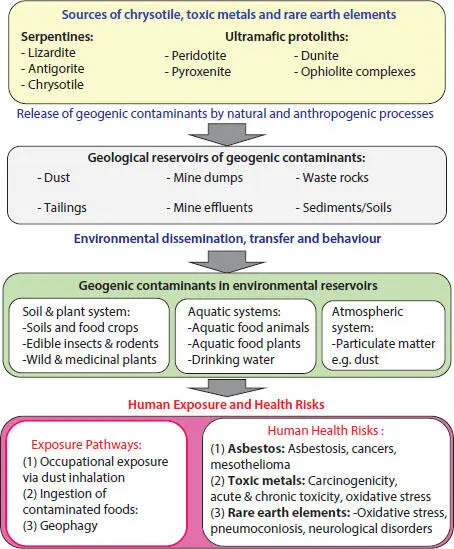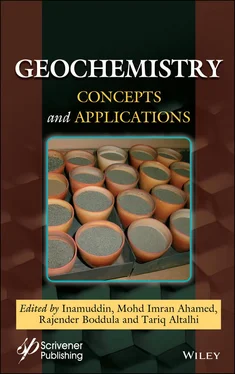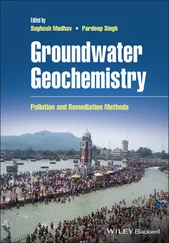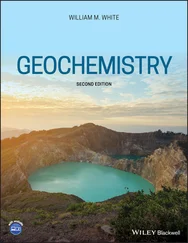Keywords:Serpentines, ultramafics, medical geology, toxic metals, chrysotile asbestos, rare earth elements, asbestosis, human exposure pathways
Serpentinitic geological environments, consisting of serpentines and their ultramafic precursors or protoliths occur on all continents and cover about 1% of the earth surface [1]. To date, research on serpentinitic geological environments has been limited to their geology, geochemistry, and ecology [1, 2]. However, the medical geology of serpentinitic geological systems has received limited research attention. Medical geology seeks to understand how the interactions between humans and animals, and geological processes and activities influence human and animal health [3, 4]. The field of medical geology has attracted significant public and research attention, and an increasing body of literature exists on the subject [3, 5, 6]. The literature on medical geology, include (1) reviews presenting an overview of the discipline [3, 5, 6] and (2) empirical studies investigating the human health risks of specific geological processes and contaminants [7, 8].
Serpentinitic geological systems contain anomalously high concentrations of toxic geogenic contaminants, which pose human health risks. These include, toxic elements such as rare earth elements and metals, and chrysotile asbestos [3, 4, 9]. Toxic metals occurring in serpentinitic geological environments include cobalt (Co), chromium (Cr), iron (Fe), manganese (Mn), nickel (Ni), and zinc (Zn). The 17 rare earth elements include the lanthanides, Yttrium, and Scandium [10]. Unlike toxic metals and rare earth elements, chrysotile asbestos is not a chemical element, but a compound. In view of this, the term “toxic geogenic contaminants” is broadly used in this chapter to refer to both chrysotile and toxic elements. Limited reviews exist on the occurrence, human exposure, and health risks of toxic geogenic contaminants in serpentinitic geological systems. An exception is a recent review investigating the nature, biogeochemical behavior, human exposure pathways, and health risks of toxic geogenic contaminants in serpentinitic ultramafic geological systems [4].
The current chapter seeks to present an overview of the nature, occurrence, environmental behavior, and human exposure pathways and health risks associated with toxic geogenic contaminants in serpentinitic geological systems. The specific objectives are to (1) discuss the occurrence and environmental behavior of toxic geogenic contaminants, (2) summarize the human exposure and health risks of toxic geogenic, and (3) highlight mitigation measures and future research needs. Figure 1.1summarizes the key focus on the chapter, including the nature, human exposure pathways, and health risks of toxic geogenic contaminants in serpentinitic geological systems and their ultramafic protoliths.

Figure 1.1 Summary of the nature, environmental sources, and human exposure and health risks of toxic geogenic contaminants in serpentinitic geological systems and their ultramafic protoliths. Adapted and redrawn based on Gwenzi [4].
1.2 Serpentinitic Geological Systems
1.2.1 Nature, Occurrence, and Geochemistry
The serpentine group consists of three minerals: (1) chrysotile, which is a type of asbestos; (2) antigorite; and (3) lizardite ( www.minerals.net; www.geology.com). The hydrothermal transformation of ultramafic rocks or protoliths such pyroxenites and peridotites results in the formation of serpentines [9, 11]. In this chapter, the term serpentinitic geological systems is broadly used to refer to both serpentines sensu stricto , and their ultramafic protoliths or precursor rock assemblages. This is because both serpentines and their ultramafic protoliths contain anomalously high concentrations of toxic contaminants [4].
Serpentinitic geological systems are sparsely distributed across all continents, particularly along plate convergent boundaries such as Circum-Pacific margin [4]. Countries hosting significant serpentinitic geological systems include, the USA (California, Oregon), Spain, Australia (Western Australia), Sri Lanka and Zimbabwe (Great Dyke) [4, 12–15]. In Africa, the Great Dyke in Zimbabwe is linear ultramafic geological formation hosting serpentinitic geological systems and other associated petrological assemblages [4, 16, 17]. Serpentinitic geological systems have a unique geochemistry, defined by anomalously high concentrations of toxic contaminants [1]. Of human health concerns are high concentrations of chrysotile asbestos, toxic metals specifically Cr, Ni, Fe, Mn, Co, and Cd [1, 9], and potential enrichment of rare earth elements.
Toxic contaminants in serpentinitic geological systems are released via natural and anthropogenic activities. Natural processes include biotic and abiotic weathering processes, and subsequent erosion and mass movement [18]. Anthropogenic activities include agriculture (i.e., tillage practices) and mining operations including metallurgical processing, construction, and sculpturing, carving, and engraving [4]. Once released from the host rock toxic contaminants are widely disseminated via wind and hydrologically-mediated processes. These processes include surface and sub-surface runoff, water and wind erosion, infiltration and groundwater recharge, and surface water-groundwater exchanges [4]. Moreover, due to the low moisture retention and infiltration of serpentine soils, they are highly susceptible to high runoff, erosion and mass movement (e.g., landslides) [19]. Therefore, the toxic contaminants from serpentinitic geological systems tend to be widely disseminated into the surrounding environment, resulting in off-site environmental pollution and human health risks [4, 19].
1.2.2 Occurrence and Behavior of Toxic Contaminants
1.2.2.1 Chrysotile Asbestos
Chrysotile is a fibrous asbestos mineral, which is a human carcinogen [4, 20]. Due to its toxicity, chrysotile and other types of asbestos have been long-banned in most developing countries. The physico-chemical behavior of chrysotile is defined by its crystal habit, fiber size, chemical composition, biopersistence, and surface reactivity, including capacity to generate reactive oxygen radicals [4, 21, 22]. Its fibrous nature, low density, and long residence time, coupled with unique aerodynamic properties make it a unique contaminant. For example, due to its biopersistence and aerodynamic properties, chrysotile can be transported over long distances from the sources to other environmental compartments [4]. Chrysotile undergoes limited biochemical degradation and is not taken up by plants due to its fibrous nature. Evidence shows that acid rain may promote the corrosion of chrysotile, and its release into the environment. In serpentinitic geological systems, chrysotile co-occurs with other contaminants such as toxic metals [21–23], thus may act as a carrier in this regard. The co-occurrence of chrysotile and other toxic contaminants points to potential synergistic interactions between the two, a process reported to have adverse human health effects [21, 22].
A few studies exist on the environmental and biogeochemical behavior of chrysotile, particularly in aqueous systems [24, 25]. The following summary findings are evident from existing data: (1) coagulation and filtration significantly remove chrysotile in aqueous systems, including drinking water supplies [26], (2) strong organic acids promote the loss of crystallinity, and release of Mg, which alters the surface charge from an initial positive to a negative one [24, 25]. Therefore, some studies suggest that the release of organic acids from organic amendments (sawdust, peat, compost, manure, and biochar) can be used as basis to reclaim serpentinitic geological systems such as mine tailings and waste dumps [4, 24].
Читать дальше




